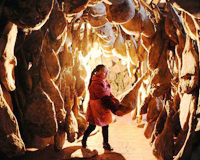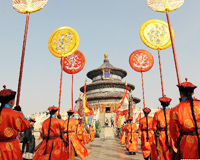
Spring Festival this year marks the beginning of the Year of the Horse according to the Chinese zodiac that assigns one of 12 animals, either real or mythological, to each year. The horse ranks seventh in the cycle, preceded by the snake and followed by the goat. A legend goes that horses used to have wings and could fly, swim and run equally fast. A horse that served as the mount of the mythological Jade Emperor became so arrogant that it forced its way into the Dragon King's Palace after killing its guardian. This infuriated the Jade Emperor, who had the horse's wings chopped off and imprisoned it underneath the Kunlun Mountains in the far west.
After more than 200 years, when a man walked by, the horse pleaded to him for help. The man was sympathetic and set the horse free. The animals have since been domesticated to become man's helpers.
Today, the horse is considered an auspicious animal. The Chinese often describe a talented person as qianli ma, meaning a steed that can cover 500 km a day.
A Chinese idiom for "at once" or "immediately" is pronounced as ma shang, which literally means "on horseback". As a result, photos showing cash, a house, or a car on horseback have become the most popular New Year's greetings this year, meaning "be rich, own a house and a car immediately".
One of the funnier photos shows a horse carrying an eggplant, which means "to own everything at once", as an eggplant is pronounced in Chinese as "everything".
Former Chinese leader Hu Jintao is among those born under the sign of horse.
In many Chinese regions, those who encounter the year of their zodiac sign are recommended to wear something red to ward off bad luck, with the most common being red string wristlets, red underpants and red socks.
What to do
Most people stay up late on the eve of Chinese New Year, watching the annual TV gala and eating snacks with their families. Those who choose to go to bed early are often woken up at midnight by fireworks, which continue for a week afterward.
The fireworks and the red decorations in front of many homes and businesses were originally intended to scare away the nian, meaning year in Mandarin, a mythical beast supposed to have preyed on people and livestock at the turn of the year. The monster, however, was afraid of loud bangs and the color red.
Although few now believe in the monster's existence, Chinese families carry on the tradition of hanging red lanterns, setting off fireworks and fixing red scrolls with rhyming phrases on their doors, hoping all the items can ward off evil spirits and bring in good luck.
What to eat
Dishes served during Spring Festival often carry symbolic meaning. In northern China, dumplings are an indispensable dish for New Year's dinner. Many believe eating them will bring fortune, because the food resembles yuan bao, a boat-shaped gold ingot that was used as currency in centuries past.
Although most dumplings are filled with vegetables, meat or fish, some families put special items, most often coins, in one of their dumplings when they are preparing their meal. The person who finds the "special dumpling" is believed to have good luck for the whole year.
In southern China, where most people prefer rice to wheat, families eat glutinous rice cakes instead of dumplings for New Year's dinner. These cakes are also symbols of a prosperous new year.
Fish and leeks are also common, as their names sound like "abundance" and "longevity".
Nowadays, the large dinners prepared during the festival feature less symbolism and are seen more as an occasion for family reunions, especially for those who live and work away from home and return once a year for the festival.
We recommend:
 |
 |
 |
| Horse-themed artworks made to greet upcoming Chinese lunar new year | A bite of Chinese New Year | Royal heaven worship ceremony rehearsal held in Beijing |
Media Support: | Chinadaily.com.cn | Ecns.cn | People's Daily Online | xinhua.net | |China.org.cn | |cntv.com | |CRI.cn |